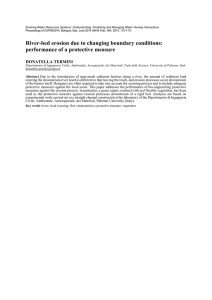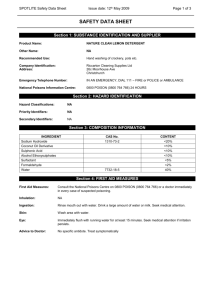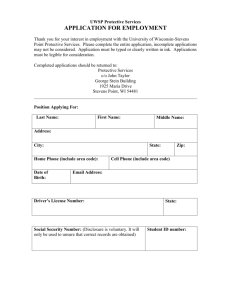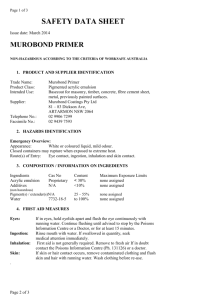IAA_safety_082012_SICK
advertisement
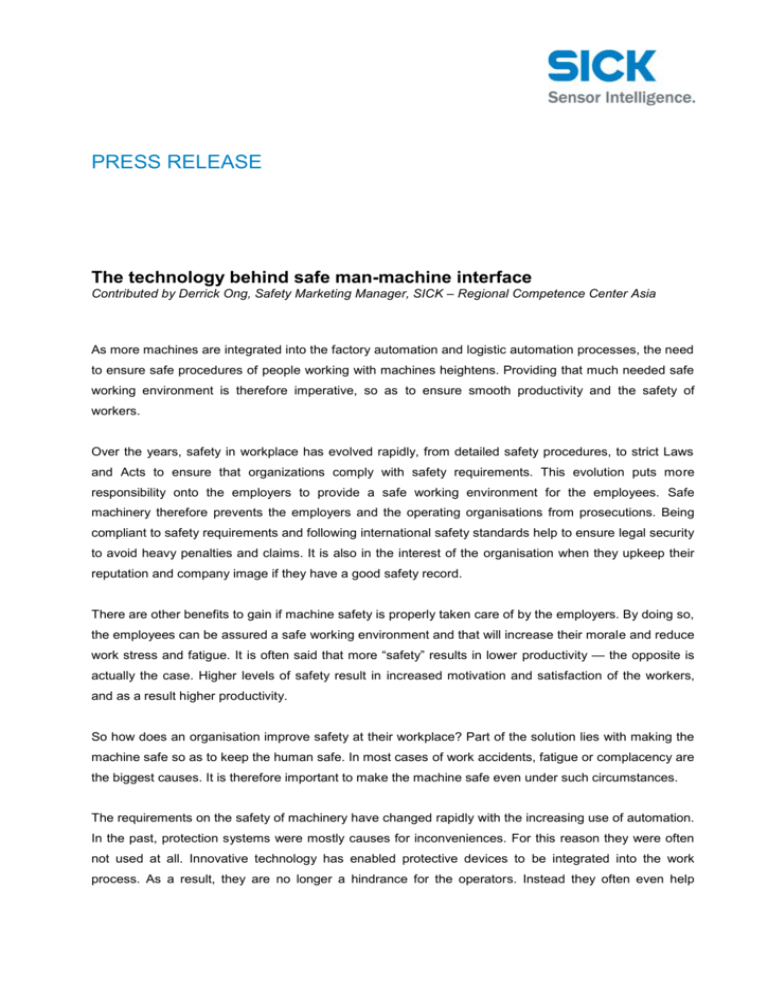
PRESS RELEASE The technology behind safe man-machine interface Contributed by Derrick Ong, Safety Marketing Manager, SICK – Regional Competence Center Asia As more machines are integrated into the factory automation and logistic automation processes, the need to ensure safe procedures of people working with machines heightens. Providing that much needed safe working environment is therefore imperative, so as to ensure smooth productivity and the safety of workers. Over the years, safety in workplace has evolved rapidly, from detailed safety procedures, to strict Laws and Acts to ensure that organizations comply with safety requirements. This evolution puts more responsibility onto the employers to provide a safe working environment for the employees. Safe machinery therefore prevents the employers and the operating organisations from prosecutions. Being compliant to safety requirements and following international safety standards help to ensure legal security to avoid heavy penalties and claims. It is also in the interest of the organisation when they upkeep their reputation and company image if they have a good safety record. There are other benefits to gain if machine safety is properly taken care of by the employers. By doing so, the employees can be assured a safe working environment and that will increase their morale and reduce work stress and fatigue. It is often said that more “safety” results in lower productivity — the opposite is actually the case. Higher levels of safety result in increased motivation and satisfaction of the workers, and as a result higher productivity. So how does an organisation improve safety at their workplace? Part of the solution lies with making the machine safe so as to keep the human safe. In most cases of work accidents, fatigue or complacency are the biggest causes. It is therefore important to make the machine safe even under such circumstances. The requirements on the safety of machinery have changed rapidly with the increasing use of automation. In the past, protection systems were mostly causes for inconveniences. For this reason they were often not used at all. Innovative technology has enabled protective devices to be integrated into the work process. As a result, they are no longer a hindrance for the operators. Instead they often even help productivity. For this reason, reliable protective devices integrated into the machines are essential today. The following steps will help an organisation to work towards a safer man-machine interface. 1. Risk assessment When designing a machine or implementing a machine into a process, the possible risks shall be analysed and, where necessary, additional protective measures shall be taken to protect the operator from any hazards that may exist. To aid the employers with this task, the standards define and describe the process of risk assessment. A risk assessment is a sequence of logical steps that permit the systematic analysis and evaluation of risks. The machine shall be designed and built, taking into account the results of the risk assessment. Understanding how the human works with the machine in all aspects of operation and maintenance is also important. Where necessary, risk reduction follows a risk assessment by applying suitable protective measures. The repetition of the entire process, risk assessment and risk reduction, may be necessary to eliminate hazards as far as possible, and to sufficiently reduce the risks identified or in some cases, new risks that that are created out of the original risk reduction process. After the task of risk assessment, the next stage is to apply the risk reduction process. 2. Safe design Safe design (inherently safe design) is the first and most important step in the risk reduction process. During this process, possible hazards are identified and avoided during the design stage. The desired safe design is integrated into the machine, and the interaction between the person at risk and the machine. Examples: mechanical design operating and maintenance concepts electrical equipment (electrical safety, EMC) concepts for stopping during an emergency situation equipment involving fluids used materials and lubricants machine function and production processes In any case all safety aspects with the use of suitable components are to be considered, and adapted such that in the event of a fault on the machine, the safety of people is paramount. The prevention of Page 2 of 7 damage to the machine and the surroundings are also to be considered. All elements of the machine design are to be specified so that the functions are performed within the related limits allowed. 3. Technical protective measures Technical protective measures are necessary when the identified risks cannot be reduced by design measures. Technical protective measures can be realized by means of protective devices like safety switches or safety locking devices which monitors covers and doors, safety light curtains or safety laser scanners which protects the operators who are working very near to a hazardous point or monitoring the access into hazardous areas, or safety monitoring units to monitor the velocity and positions of automated robots and vehicles. The appropriate protective devices must be selected as part of the technical protective measure after identifying the safety tasks. Safety tasks are identified risk factors which need to be addressed. Examples: Safety task: Hazardous point protection with finger or hand protection Objective: Protect the operators working in close proximity to the hazardous point Safety protective devices: Safety light curtain, safety camera system The appropriate resolution of detection and safety distance between the protective device and the hazard point must be calculated carefully, so that upon detection of a dangerous access, the machine must stop before any harm is caused. Safety task: Access protection and hazardous area protection of a person (body) Objective: Protects an operator when entering a hazardous area Safety protective devices: Safety light curtain, safety laser scanner A large area is protected with zone protection. Multiple directions access protection is possible with mirror columns. Safety task: Access protection with muting Page 3 of 7 Objective: Protects access with ability to differentiate between persons and material Safety protective devices: Safety light curtain with muting functions, safety laser scanner with muting functions Very useful for machines with automated pallet loading. Cleverly designed to be smart enough to perform muting and entry/ exit monitoring of human and material. Safety task: Hazardous area protection of a mobile application (AGV) Objective: Protection of persons during movement of vehicles and prevention of collision. Safety protective devices: Safety laser scanner A well integrated system of safety laser scanners can perform an all-round protection of the area around the mobile vehicle. Safety task: Monitoring and interlocking of movable guards Objective: If the doors or guards are opened, the machine or hazardous machine functions must stop Safety protective devices: Mechanical safety switches, magnetic switches, transponder safety switches In cases when ejection of parts, heat or radiation presents a hazard! Movable physical guards (with locking function, if necessary), or physical guards (fences, barriers, etc.) must be used. In such cases, interlocking of movable guards must be implemented. Safety task: Temporary prevention of access Objective: Prevents a person from access into a hazardous area when the machine is running-down or stopping Safety protective devices: Safety locking devices It is useful when a hazardous machine function takes too long a time to stop, or if a process is not allowed to be interrupted. Page 4 of 7 Safety task: Safe monitoring of the working position of a robot and automatic guided vehicle (AGV) Objective: To monitor if the robot or AGV is operating out of the safe zone Safety protective devices: Inductive safety switches, safety position switches Useful in preventing harm to human or damage to properties when robots or AGVs malfunctions. Task: Safe control and communication Objective: Safe integration and control - combining or switching safety functions Safety protective devices: Safety relays, safety controllers, network solutions Safe control units for linking and evaluating a variety of input signals of the safety functions to produce output signals. After identifying the hazards and determining the safety functions with the protective devices, it is in the next important step to determine the level of safety necessary. The level of safety necessary is to be defined individually for each safety function and then also applies to all devices involved in the safety system, e.g. … the sensor/the protective device the evaluating logic unit the actuator(s) By means of the application of the standards, it is ensured that the effort for implementation is reasonable for the risk defined. The protection of an operator who manually inserts and removes parts at a metal press requires different consideration when comparing to the protection of an operator who works on a machine on which the maximum risk is the trapping of a finger. Page 5 of 7 The basis for all safety standards are the following parameters from the risk evaluation: the severity of the possible injury/harm to the health the frequency and/or the duration of the exposure to the hazard the possibility of preventing the hazard The combination of the parameters determines the safety level required. After which, the safety category level of the protective devices can be decided, taking into consideration, the structure of the control system, the reliability of the components used, the ability to detect failures as well as the resistance to multiple common causes failures in multiple channel control systems. In addition, further measures to avoid design faults are required. 4. User information on residual risks If the safe design and technical protective measures are not completely effective, the user shall be warned about residual risks and informed about necessary suggestions. These include e.g.: warnings in the operating instructions work instructions, training requirements or user familiarisation visible warning signs and pictograms notes for the use of personal protective equipment User information shall not be a replacement for safe design and technical protective measures. 5. Overall validation of the machine As functional safety is only part of the risk reduction, it is necessary to evaluate all measures — that is design, technical and organisational — together in an overall validation. It is therefore possible in practice that, although risk reduction is not achieved with a single technical protective measure, an adequate safety function result can be achieved in the overall assessment. Adequate risk reduction can be achieved if all the following questions can be answered positively: Have all operating conditions in all phases of the life of the machine been taken into consideration? Have the hazards been eliminated or the risks associated with the hazards reduced as far practically feasible? Is it ensured that the measures implemented will not result in new hazards? Has the risk been appropriately reduced? Have the users been sufficiently informed and warned about the residual risks? Is it ensured that the operators’ working conditions are not impaired by the protective measures taken? Page 6 of 7 Are the protective measures implemented compatible? Have the consequences that could result from the usage of the machine in the noncommercial/non-industrial sector been adequately taken into account? Is it ensured that the measures implemented do not excessively impair the correct function of the machine? 6. Putting the machine into use Before the machine can be used, it is the responsibility of the employer to ensure that; all safety functions have been implemented as practically feasible as possible all applicable safety standards have been taken into account the conformity to safety has been determined during the overall validation involve the services of a professional safety services provider where necessary This safety implementation must be included in the technical documentation. It is important as an employer to go through the mentioned steps and processes to ensure that the machine is safe. When machines are safe, the machine operators are safe. The results can be measured when seamless man-machine interface encourages improvement in productivity. Safe machines also help employers to avoid production downtime due to accident investigations, legal proceedings and unnecessary injury compensations. The investment into ensuring safe machine is definitely worth it in all aspect. Word count: 1,993 The appropriate selection of the protective devices with the corresponding product technologies for the implementation of safety functions in a machine depends on the correct identification of the safety task.SICK is one of the world's leading manufacturers of sensors and sensor solutions for industrial applications. Founded in 1946 by Dr.-Ing. e. h. Erwin Sick, the company is headquartered in the German town of Waldkirch, in the Breisgau region near the city of Freiburg. It is a technology and market leader, maintaining a global presence with more than 50 subsidiaries and equity investments as well as numerous representative offices. In the 2014 fiscal year, SICK had around 7,000 employees worldwide and generated Group revenues of €1,099.8 million. Page 7 of 7


